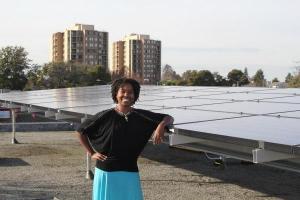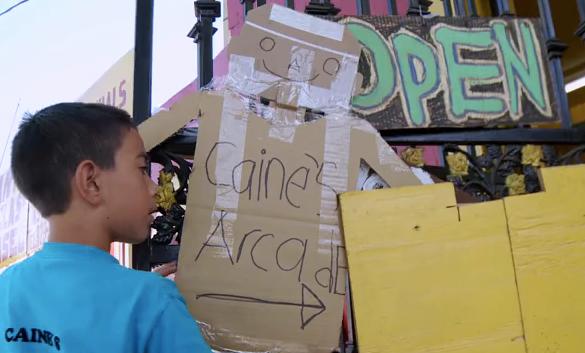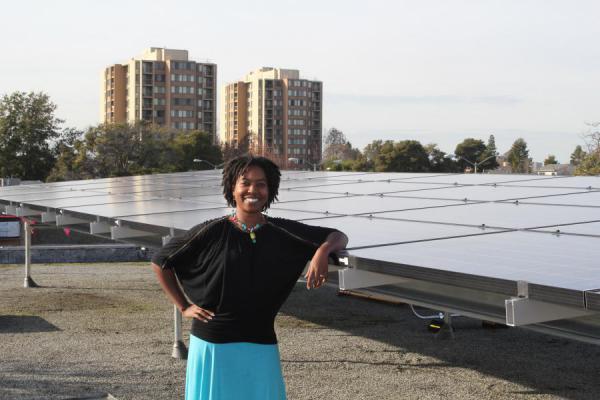
Nikki Henderson, executive director of People's Grocery, with the community solar project that is expected to save her organization more than $30,000 over the 20-year lease.
Here’s a not-terribly-novel idea: Get a bunch of people together, pool your money, and invest it in a project or a business that will make enough money to pay you back — hopefully with interest. Banks do it, right? And it seems like a decent way to fund promising green technology like solar power.
Or you’d think so, anyway.
Banks will fund huge commercial solar projects, but when it comes to community-level solar installation, they won’t touch it, says Billy Parish, president of Solar Mosaic, a Berkeley, Calif.-based company that seeds local solar projects. “When we were first getting started, we went looking for funding from banks,” he says. “Wells Fargo told us, ‘Come back to us when you have a book of $50 to $100 million worth of projects.’”
That just wasn’t gonna happen. And that’s why Solar Mosaic’s seemingly mundane business model is so interesting.
Here’s how it works: Solar Mosaic picks a worthy solar project. I’ll use its latest project as an example: the Society of St. Vincent de Paul of Alameda County, a nonprofit that provides free meals, job training, and other services to the needy in Oakland, Calif. To raise the $88,500 required to put solar panels on the organization’s roof, Solar Mosaic is collecting money — large sums and small — from investors who want to see the project succeed. Once the panels are up, St. Vincent de Paul will pay a monthly fee to lease the panels on its roof, providing Solar Mosaic with the cash to pay back its investors — and all the while saving money on its utility bill. At press time, the project was just $1,400 short of its goal.
Solar Mosaic started using this “crowdfunding” model in 2010, and to date, the company has raised roughly $320,000 to fund five solar installations, including an array atop People’s Grocery, a food justice organization in Oakland, as well as the home of artist Shonto Begay on the Navajo Nation in Arizona. It’s similar to the microfinance nonprofit Kiva, which raises money for small businesses around the world. And, like Kiva, its loans are paid back sans interest — you put $100 toward the solar panels for St. Vincent de Paul, and you’ll get $100 back.
But Parish says that’s about to change. Starting this summer, the company will offer investment products that it estimates will pay 5 to 10 percent returns. These products will allow everyday people to get in on a booming business, he says. Bloomberg recently reported that Warren Buffett and Google are pouring billions into solar energy development, lured by 15 percent returns.
“Why would I invest in Solar Mosaic instead of going out and buying a little stock,” you ask? Read this heartwarming letter from former Goldman Sachs Executive Director Greg Smith and then repeat after me: “I am not a muppet. I am not a muppet. I am not … ”
“A lot of people are afraid to put money into the stock market these days, and for good reason,” Parish says. “Young people especially are looking for ways for their money to earn a good rate of return and do something good in the world.”
It’s true that as with any investment, there’s a risk that you’ll lose your shirt. But at least you’ll have the satisfaction of having created clean energy and green jobs and supporting a project that’s easy to get your head around (derivatives, wha?). Besides, Parish points out, your investment is backed by the solar panels themselves, which continue to generate electricity — and revenue — even if the tenants change in the building below.
It’s solar power brought to you by the people, a rooftop revolution grown from the grassroots.




